1.5: Urban Blues
- Page ID
- 168900
\( \newcommand{\vecs}[1]{\overset { \scriptstyle \rightharpoonup} {\mathbf{#1}} } \)
\( \newcommand{\vecd}[1]{\overset{-\!-\!\rightharpoonup}{\vphantom{a}\smash {#1}}} \)
\( \newcommand{\dsum}{\displaystyle\sum\limits} \)
\( \newcommand{\dint}{\displaystyle\int\limits} \)
\( \newcommand{\dlim}{\displaystyle\lim\limits} \)
\( \newcommand{\id}{\mathrm{id}}\) \( \newcommand{\Span}{\mathrm{span}}\)
( \newcommand{\kernel}{\mathrm{null}\,}\) \( \newcommand{\range}{\mathrm{range}\,}\)
\( \newcommand{\RealPart}{\mathrm{Re}}\) \( \newcommand{\ImaginaryPart}{\mathrm{Im}}\)
\( \newcommand{\Argument}{\mathrm{Arg}}\) \( \newcommand{\norm}[1]{\| #1 \|}\)
\( \newcommand{\inner}[2]{\langle #1, #2 \rangle}\)
\( \newcommand{\Span}{\mathrm{span}}\)
\( \newcommand{\id}{\mathrm{id}}\)
\( \newcommand{\Span}{\mathrm{span}}\)
\( \newcommand{\kernel}{\mathrm{null}\,}\)
\( \newcommand{\range}{\mathrm{range}\,}\)
\( \newcommand{\RealPart}{\mathrm{Re}}\)
\( \newcommand{\ImaginaryPart}{\mathrm{Im}}\)
\( \newcommand{\Argument}{\mathrm{Arg}}\)
\( \newcommand{\norm}[1]{\| #1 \|}\)
\( \newcommand{\inner}[2]{\langle #1, #2 \rangle}\)
\( \newcommand{\Span}{\mathrm{span}}\) \( \newcommand{\AA}{\unicode[.8,0]{x212B}}\)
\( \newcommand{\vectorA}[1]{\vec{#1}} % arrow\)
\( \newcommand{\vectorAt}[1]{\vec{\text{#1}}} % arrow\)
\( \newcommand{\vectorB}[1]{\overset { \scriptstyle \rightharpoonup} {\mathbf{#1}} } \)
\( \newcommand{\vectorC}[1]{\textbf{#1}} \)
\( \newcommand{\vectorD}[1]{\overrightarrow{#1}} \)
\( \newcommand{\vectorDt}[1]{\overrightarrow{\text{#1}}} \)
\( \newcommand{\vectE}[1]{\overset{-\!-\!\rightharpoonup}{\vphantom{a}\smash{\mathbf {#1}}}} \)
\( \newcommand{\vecs}[1]{\overset { \scriptstyle \rightharpoonup} {\mathbf{#1}} } \)
\(\newcommand{\longvect}{\overrightarrow}\)
\( \newcommand{\vecd}[1]{\overset{-\!-\!\rightharpoonup}{\vphantom{a}\smash {#1}}} \)
\(\newcommand{\avec}{\mathbf a}\) \(\newcommand{\bvec}{\mathbf b}\) \(\newcommand{\cvec}{\mathbf c}\) \(\newcommand{\dvec}{\mathbf d}\) \(\newcommand{\dtil}{\widetilde{\mathbf d}}\) \(\newcommand{\evec}{\mathbf e}\) \(\newcommand{\fvec}{\mathbf f}\) \(\newcommand{\nvec}{\mathbf n}\) \(\newcommand{\pvec}{\mathbf p}\) \(\newcommand{\qvec}{\mathbf q}\) \(\newcommand{\svec}{\mathbf s}\) \(\newcommand{\tvec}{\mathbf t}\) \(\newcommand{\uvec}{\mathbf u}\) \(\newcommand{\vvec}{\mathbf v}\) \(\newcommand{\wvec}{\mathbf w}\) \(\newcommand{\xvec}{\mathbf x}\) \(\newcommand{\yvec}{\mathbf y}\) \(\newcommand{\zvec}{\mathbf z}\) \(\newcommand{\rvec}{\mathbf r}\) \(\newcommand{\mvec}{\mathbf m}\) \(\newcommand{\zerovec}{\mathbf 0}\) \(\newcommand{\onevec}{\mathbf 1}\) \(\newcommand{\real}{\mathbb R}\) \(\newcommand{\twovec}[2]{\left[\begin{array}{r}#1 \\ #2 \end{array}\right]}\) \(\newcommand{\ctwovec}[2]{\left[\begin{array}{c}#1 \\ #2 \end{array}\right]}\) \(\newcommand{\threevec}[3]{\left[\begin{array}{r}#1 \\ #2 \\ #3 \end{array}\right]}\) \(\newcommand{\cthreevec}[3]{\left[\begin{array}{c}#1 \\ #2 \\ #3 \end{array}\right]}\) \(\newcommand{\fourvec}[4]{\left[\begin{array}{r}#1 \\ #2 \\ #3 \\ #4 \end{array}\right]}\) \(\newcommand{\cfourvec}[4]{\left[\begin{array}{c}#1 \\ #2 \\ #3 \\ #4 \end{array}\right]}\) \(\newcommand{\fivevec}[5]{\left[\begin{array}{r}#1 \\ #2 \\ #3 \\ #4 \\ #5 \\ \end{array}\right]}\) \(\newcommand{\cfivevec}[5]{\left[\begin{array}{c}#1 \\ #2 \\ #3 \\ #4 \\ #5 \\ \end{array}\right]}\) \(\newcommand{\mattwo}[4]{\left[\begin{array}{rr}#1 \amp #2 \\ #3 \amp #4 \\ \end{array}\right]}\) \(\newcommand{\laspan}[1]{\text{Span}\{#1\}}\) \(\newcommand{\bcal}{\cal B}\) \(\newcommand{\ccal}{\cal C}\) \(\newcommand{\scal}{\cal S}\) \(\newcommand{\wcal}{\cal W}\) \(\newcommand{\ecal}{\cal E}\) \(\newcommand{\coords}[2]{\left\{#1\right\}_{#2}}\) \(\newcommand{\gray}[1]{\color{gray}{#1}}\) \(\newcommand{\lgray}[1]{\color{lightgray}{#1}}\) \(\newcommand{\rank}{\operatorname{rank}}\) \(\newcommand{\row}{\text{Row}}\) \(\newcommand{\col}{\text{Col}}\) \(\renewcommand{\row}{\text{Row}}\) \(\newcommand{\nul}{\text{Nul}}\) \(\newcommand{\var}{\text{Var}}\) \(\newcommand{\corr}{\text{corr}}\) \(\newcommand{\len}[1]{\left|#1\right|}\) \(\newcommand{\bbar}{\overline{\bvec}}\) \(\newcommand{\bhat}{\widehat{\bvec}}\) \(\newcommand{\bperp}{\bvec^\perp}\) \(\newcommand{\xhat}{\widehat{\xvec}}\) \(\newcommand{\vhat}{\widehat{\vvec}}\) \(\newcommand{\uhat}{\widehat{\uvec}}\) \(\newcommand{\what}{\widehat{\wvec}}\) \(\newcommand{\Sighat}{\widehat{\Sigma}}\) \(\newcommand{\lt}{<}\) \(\newcommand{\gt}{>}\) \(\newcommand{\amp}{&}\) \(\definecolor{fillinmathshade}{gray}{0.9}\)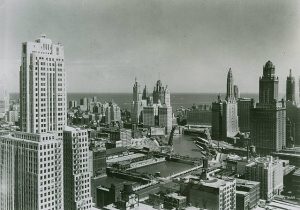
Urban Blues developed in urban environments such as Chicago and New York. During World War I many African Americans migrated to northern cities for industrial jobs, some whom were musicians trained in country/delta blues. Urban blues developed when these musicians began forming groups with other musicians instead of only accompanying themselves on solo guitar.
Groups included rhythm sections with drums, bass, guitar or piano, and solo instruments (usually saxophones or some other wind instrument). These emerging groups were loud, and the acoustic guitar could not match the volume and power of horns and drums. Simultaneously, electronic amplification was being developed to remedy this issue, and soon the electric guitar was born.
The Electric Guitar
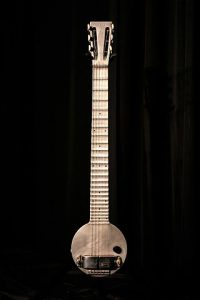
Perhaps no other piece of technology shaped 20th century popular music more than the electric guitar. A peripheral curiosity at first, by the 1950s the electric guitar had become an indispensable tool for guitarists wishing to be heard among the louder instruments of popular music such as drums and horns. Designed for the express purpose of more volume in a group context, guitarists were relatively slow to adopt this new instrument that required being plugged into a wall outlet at all times. However, the potential of this instrument was eventually realized. When the phenomenal jazz guitarist Charlie Christian began playing an electric guitar, the music world could, for the first time, actually hear a single-note guitar solo among the *loud* big band texture. It didn’t take long before most guitarists followed suit.
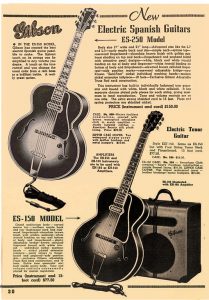
The acoustic guitar relies on the natural resonance of a hollow body constructed out of hard wood. The resulting sound is beautifully rich and full, but lacking in volume when compared to other acoustic instruments like horns, drums, and piano. The first solution to this problem was to build larger bodied guitars, but there was still a threshold of volume that limited guitarists from being heard clearly in a musical group context. By the 1920s and 1930s, some guitar makers and inventors were toying with the idea of adding an electro-magnetic pickup on the guitar body to convert the vibrations of the steel strings into electrical signal. This signal could be electrically amplified, converted back into sound, and transmitted through a loudspeaker. This breakthrough was the beginning of a major change in the sound of popular music.
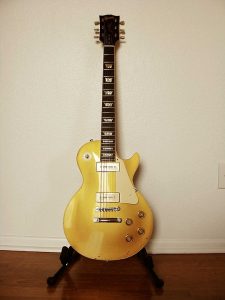
For the first decade-plus of commercial electric guitar production, most guitars were simply acoustic guitars with electromagnetic pickups mounted to the body. As resonant and beautiful sounding these guitars are, the louder you get, the more they are prone to electronic feedback (demonstrated below). As rhythm and blues became more popular in the 1940s (eventually morphing into Rock & Roll) bands became more energetic (ie. LOUDER) and guitarists were again running into problems. This was rectified by two companies: Gibson and Fender. At Gibson, the popular guitarist/inventor Les Paul had invented what he termed “The Log”, a guitar with a solid block in the middle to dampen the vibrations that led to feedback. This eventually led to the 1952 introduction of the Gibson Les Paul (pictured below). An elegant design and the first signature guitar ever, the Les Paul model used a completely solid body to dampen the resonance and increase the instrument’s resistance to feedback.
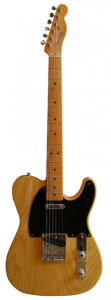
Around the same time (1950) Leo Fender was working on a similar design. Originally called the Broadcaster, the Telecaster became the first commercially available solid body guitar. This guitar was a simple design, built from modules that could be screwed together and disassembled with relative ease. The body was a solid plank of wood, and it was equipped with bright sounding pickups. Both the Telecaster and the Les Paul became mainstays of popular music, and remain among the best selling guitars on the market to this day.

The electric guitar can’t make much sound without an amplifier. The amplifier is the device that takes the electric signal from the guitar’s pickups and powers it. The electric signal travels through transformers and vacuum tubes, the same devices used in radios and televisions at the time. The signal is then converted back to audio and travels out of the speaker. The evolution of guitar amplifiers from the 1940s-1970s is a long and complex story, but can be summarized very simply by this: they started as relatively quiet devices and became louder and louder over time.
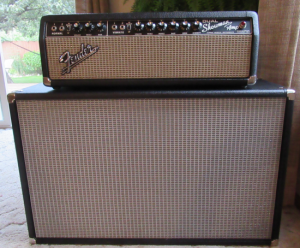
Listening Examples 5.1
First, review the “12 Bar blues form” and “Delta Blues guitar techniques”. I play through many of the characteristics listed in the class notes on Delta Blues Techniques to give you an idea what they sound like in isolation.
Second, listen as I play an electric guitar to show the difference in sound from an acoustic guitar. As I show, this particular model is a solid body, meaning it has no hollow cavity or sound hole to naturally amplify such as an acoustic guitar has. This means that, unplugged, this guitar is very quiet. I demonstrate the sound unplugged first, then gradually turn the volume up, and I play some blues-style melodic fills. Notice how the notes sustain for a longer time than those played on the acoustic guitar. Electric guitars enabled guitarists to play melodic lines comparable to those played by saxophones.
Third, listen to the following examples:
- Electric Guitar Amplifier
- Amplifier Overdrive (I play an excerpt of “Rumble” by Link Wray, and early example of electric guitar overdrive)
- “I’m Gonna Murder My Baby” by Pat Hare (1954), an early example of very overdriven electric guitar.
- Electronic Feedback
- Electric Slide Guitar
T-Bone Walker
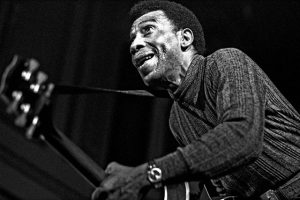
T-Bone Walker – (1910–1975) One of the earliest blues musicians to use electric guitar as a solo instrument. Walker grew up playing country blues guitar and was influenced by Blind Lemon Jefferson who played long and complex melodic fills between his vocal lines. This style transferred naturally to electric guitar. His music would be very influential on future performers including B.B. King and Jimi Hendrix.
Walker developed a flashy guitar style playing embellished versions of the melody on guitar. He would often solo for an entire ‘chorus’ (an entire AAB section in 12 bar blues form) or more and improvise melodic ‘lead’ lines. Also, these lead lines often served as a response to his vocal lines, much like the call and response that Robert Johnson utilized. In his early years, his stage performance was extremely colorful. Walker would play the guitar behind his head and back, perform wild dance moves including the splits.
Chicago Blues
Chicago would become one of the most important single areas in the development of urban blues and even had a particular style so associated with it that it was named “Chicago Blues”. Chicago Blues often combined swing jazz and “boogie woogie” piano with delta blues. The music was played by bands and consequently required the new electric guitar.
Chess Recording Studios – Run by brothers Phil and Leonard Chess, this company was responsible for much of the blues recorded in the 1950’s. Many musicians with a background in country blues came to Chess and were given backup musicians/amplification forming urban blues.
Muddy Waters
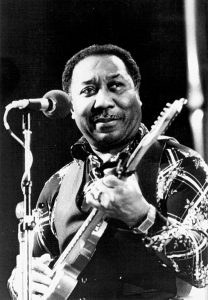
Muddy Waters – (1913–1983) was an urban blues musician whose rustic style was more closely related to his delta blues roots than many other urban blues musicians. Waters began playing in a rural delta blues style on acoustic guitar. He was ‘discovered’ and recorded by renowned American musicologist Alan Lomax. When Waters heard himself on record for the first time it provided confidence for him to pursue a career in music and move to Chicago where he formed a group.
He often utilized the sound of a bottleneck slide with electric guitar much in the way delta blues players like Robert Johnson had done on acoustic guitars, retaining much of the spirit of delta blues into his new full band electric style.
His song “Rollin’ Stone (Catfish Blues)” (1948, featured in Ch. 5.2 Listening Examples) was an early hit for Waters. It is a reworking of a song called “Catfish Blues” by songwriter Robert Petway. Rather than use a standard 12-bar form, the song uses only a single chord and single bass note throughout, while short, repetitive lines are repeated on the electric guitar and the piano. This approach to blues song form can be called a “riff-driven blues vamp”. Formally, there are multiple sub-sections with slight variations (some vocal, some instrumental) that flow into one another and then repeat.
Though it deviates from standard blues forms, many musical characteristics of the blues are retained. The vocal lines use blue notes and the pentatonic scale. Rhythmically, the uneven beat subdivisions so common in blues and jazz permeate the music. Waters’ guitar work is minimal, but uses the technique of string bending which adds to the expressiveness.
Elmore James
Elmore James – (1918–1963) Is considered one of the early modernizers of delta blues. Originally from Mississippi, James claimed to have played with Robert Johnson who apparently suggested using a metal pipe (rather than the standard glass bottleneck) as a slide. Like Muddy Waters, he began playing in the delta blues style and moved from Mississippi to Chicago to perform and record.
He was among the first delta blues musicians to work with groups that included saxophone, piano, and drums on a regular basis. James was also one of the most influential electric slide players, providing important influence on later electric slide players such as Duane Allman.
B.B. King
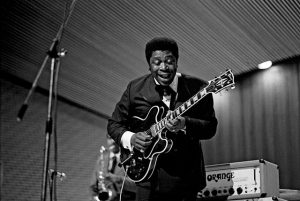
B.B. King – (1925-2015) Was one of the best known blues musicians, and one of the most influential as well, with Eric Clapton, Jimmy Page, Jimi Hendrix, and many others citing him as a key influence. Many rock guitarists of the 1960s and beyond have emulated the sophisticated melodic work of King.
King grew up in Mississippi delta where he absorbed the blues from delta blues musicians and was influenced by gospel music through singing in church as a child. Beginning in the 1940s, King began playing professionally and maintained an extremely busy schedule usually involving playing over 300 shows a year.
King’s approach to playing the electric guitar is based in melodic phrasing more than accompaniment work, and the guitar lines have equal importance with the vocal lines. This is a product of having the increased volume capabilities of the electric guitar. He rarely plays chords while singing, but instead fills the space between vocal sections with lead guitar lines, ie. call and response. Compare this to the call and response found in the example by Robert Johnson, “Crossroad Blues” ( 3.2 Listening Examples) In this way, King’s guitar style can be seen an extension of his voice. The use of string bending and wide vibrato (‘shaking’ of the notes similar to vibration) resemble the sound of the voice.
Part of the “urbanization” of urban blues in contrast to delta blues is the formal regularity of even beat patterns and bar lengths in the song structure. The work of B.B. King displays this newer, tight-knit “urban” formal structure. King’s music is a very refined and clean sounding blues, with every player improvising within their well-defined roles. In other words, you can count to 12 bars here, every time! That being said, King’s voice and guitar work manage to maintain a degree of rawness, spontaneity, and improvisational ingenuity into his refined-sounding music.
Howlin’ Wolf
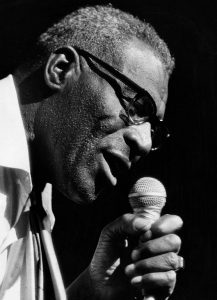
Howlin’ Wolf – (1910–1976) Born Chester Arthur Burnett, his nickname derived from the growl and timbre of his distinctive voice. In addition to vocals, he played guitar and harmonica. Wolf also claimed to have played with Robert Johnson who had an influence on his guitar style, and Sonny Boy Williamson No. 1 (the original) from whom he learned to play harmonica. Many songs and recordings by Howlin’ Wolf were not traditional blues form, but still retained many blues characteristics.
His rough style kept him away from the pop charts, but his influence was important on musicians as diverse as the Rolling Stones, the Grateful Dead, the Yardbirds, Led Zeppelin, Cream, the Doors, Captain Beefheart and Frank Zappa.
Sonny Boy Williamson
Sonny Boy Williamson – (1899–1965) One of the most influential blues harmonica (blues “harp”) players. Williamson is sometimes called “Sonny Boy No. 2” because it was the same stage name as another established musician. Considered by many as one of the best and most influential blues harmonica players, Williamson toured Britain in 1963, recorded live albums with the Yardbirds. Williamson had a strong influence on young British musicians at the beginning of the British Blues Boom because he was willing to play with and teach them.
Willie Dixon

Willie Dixon – (1915-1992) was a composer, producer, talent scout, bass player, and singer at Chess Recording Studios. Best known as a blues songwriter who wrote hits for other artists such as “You Shook Me”, “I Can’t Quit You Baby”, “Little Red Rooster”, and “(I’m Your) Hoochie Coochie Man”. His association with Muddy Waters is particularly notable, as many of Muddy Water’s most well known songs he performed were written by Dixon. His songs have since become classics and have been covered by many blues and rock musicians such as Howlin’ Wolf and later, Eric Clapton, Jimi Hendrix, and Led Zeppelin.
T-Bone Walker: T-Bone Walker Live, performing “Stormy Monday” on electric guitar. The song is in 12-bar blues form, so try and identify the different sections. Listening to the lyrics may be the easiest way to identify the form (remember, 12-bar blues form uses an AAB lyrical scheme where A is the same line of text, and B is a contrasting line of text). Also, notice the use of call and response between his voice and his guitar lines. This is a common feature in Urban Blues. “Baby You Broke My Heart” by T-Bone Walker. Try to identify on your own whether or not the song is in 12-bar blues form. Remember to listen for the lyrics.
Muddy Waters:
- “Manish Boy” by Muddy Waters
- “Manish Boy” by Muddy Waters (Live 1971)
Elmore James:“I’ll Dust My Broom” represents a synthesis of delta and urban blues, featuring delta blues guitar techniques played on an electric guitar with a full group. Listen to the example below, and try to identify whether the song is in 12-bar blues form or some other form. Again, listening for AAB in the lyrics (Two lines of the same text, one line of contrasting text) is the easiest way to identify 12 -bar blues.
B.B. King: Listen to “Three O’Clock Blues.” The formal regularity in the music of B.B. King should make it easier to identify the form.
Howlin’ Wolf: Listen to Howlin’ Wolf’s, “Smokestack Lightning” (Starts around 1:00). Is this song in 12-bar blues form, or a riff-driven blues vamp similar to “Rollin’ Stone” by Muddy Waters?
Sonny Boy Williamson: Listen to Sonny Boy Williamson’s “Nine Below Zero” Live. Williamson makes great use of the harmonica’s melodic capabilities. Notice how he emulates vocal effects such as shaking the notes (aka “vibrato”), and bending notes. This is similar to what Robert Johnson was doing in the 1930s when he utilized slide guitar as a way to emulate the fluid sound of the voice (see “Crossroads Blues” by Robert Johnson)


